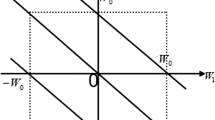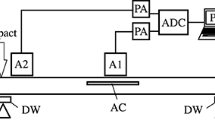Abstract
Expressions for the bispectral density functions for multi-degree-of-freedom spring–mass–damper systems possessing quadratic nonlinearities and subject to Gaussian excitation are derived. The derivation uses a Volterra-series model for the system response and yields expressions for both auto-spectra, where the output of only one degree-of-freedom is used, and cross-spectra, where the bispectral density contains multiple output-response time series. The proposed formulation is used to identify the presence and location of quadratic nonlinearities in multiple degree-of-freedom systems. Results show that the ability to detect and localize nonlinearity is heavily dependent on which particular bispectral density is utilized.
Similar content being viewed by others
References
Hinich MJ, Clay CS (1968) The application of the discrete Fourier transform in the estimation of power spectra, coherence, and bispectra of geophysical data. Rev Geophys 6(3): 347–363
Richardson AM, Hodgkiss WS (1994) Bispectral analysis of underwater acoustic data. J Acoust Soc Am 96(2): 828–837
Hinich MJ, Wilson GR (1990) Detection of non-Gaussian signals in non-Gaussian noise using the bispectrum. IEEE Trans Acoust Speech Signal Process 38(7): 1126–1131
Nyffenegger PA, Hinich MJ, Ritter D, Hansen S (2004) Material discrimination using bispectral signatures. J Acoust Soc Am 116(3): 1518–1523
Worden K, Tomlinson GR (2001) Nonlinearity in experimental modal analysis. Philos Trans R Soc A 359: 113–130
Messina AR, Vittal V (2005) Assessment of nonlinear interaction between nonlinearly coupled modes using higher order spectra. IEEE Trans Power Syst 20(1): 375–383
Rivola A, White PR (1998) Bispectral analysis of the bilinear oscillator with application to the detection of cracks. J Sound Vib 216(5): 889–910
Zhang GC, Chen J, Li FC, Li WH (2005) Extracting gear fault features using maximal bispectrum. Key Eng Mater 293(−294): 167–174
Teng KK, Brandon JA (2001) Diagnostics of a system with an interface nonlinearity using higher order spectral estimators. Key Eng Mater 204(2): 271–285
Marzocca P, Nichols JM, Milanese A, Seaver M, Trickey ST (2008) Second order spectra for quadratic non-linear systems by Volterra functional series: analytical description and numerical simulation. Mech Syst Signal Process 22: 1882–1895
Gifford SJ, Tomlinson GR (1989) Recent advances in the application of functional series to non-linear structures. J Sound Vib 135(2): 289–317
Worden K, Manson G (1999) Random vibrations of a multi-degree-of-freedom non-linear system using the Volterra series. J Sound Vib 226(2): 397–405
Worden K, Tomlinson GR (2001) Nonlinearity in structural dynamics. Institute of Physics Publishing, Bristol
Schetzen M (1980) The Volterra and Wiener theories of nonlinear systems. Wiley, New York
Krantz S (1999) The cauchy integral theorem and formula. Handbook of complex variables. BirkhSuser, Boston
Nichols JM, Milanese A, Marzocca P (2007) Characterizing the auto-bispectrum as a detector of nonlinearity in structural systems. In: Proceedings of the SPIE, health monitoring and smart nondestructive evaluation of structural and biological systems IV, vol 6532. SPIE Optical Engineering Press, Bellingham
Bedrosian E, Rice SO (1971) The output properties of Volterra systems (nonlinear systems with memory) driven by harmonic and Gaussian inputs. Proc IEEE 59(12): 1688–1707
Boyd S, Tang YS, Chua LO (1983) Measuring Volterra kernels. IEEE Trans Circuits Syst CAS-30(8): 571–577
Nikias CL, Raghuveer MR (1987) Bispectrum estimation: a digital signal processing framework. Proc IEEE 75(7): 869–891
Nichols JM, Marzocca P, Milanese A (2008) On the use of the auto-bispectral density for detecting quadratic nonlinearity in structural systems. J Sound Vib 312: 726–735
Huber PJ, Kleiner B, Gasser T, Dumermuth G (1971) Statistical methods for investigating phase relations in stationary stochastic processes. IEEE Trans Audio Electroacoust AU-19(1): 78–86
Higham DJ (2001) An algorithmic introduction to numerical simulation of stochastic differential equations. SIAM Rev 43: 525–546
Nichols JM, Olson CC, Michalowicz JV, Bucholtz F (2009) The bispectrum & bicoherence for quadratically nonlinear systems subject to non-gaussian inputs. IEEE Trans Signal Process 57(10): 3879–3890
Silva W (2005) Identification of non-linear aeroelastic systems based on the Volterra theory: progress and opportunities. Nonlinear Dyn 39: 25–62
Schetzen M (1981) Nonlinear system modeling based on the Wiener theory. Proc IEEE 69(12): 1557–1573
Bendat JS (1990) Nonlinear system analysis and identification from random data. Wiley, New York
Author information
Authors and Affiliations
Corresponding author
Rights and permissions
About this article
Cite this article
Marzocca, P., Nichols, J.M. & Milanese, A. An analytical formulation of bispectral densities for multiple degree-of-freedom systems. J Eng Math 67, 351–367 (2010). https://doi.org/10.1007/s10665-009-9349-0
Received:
Accepted:
Published:
Issue Date:
DOI: https://doi.org/10.1007/s10665-009-9349-0




